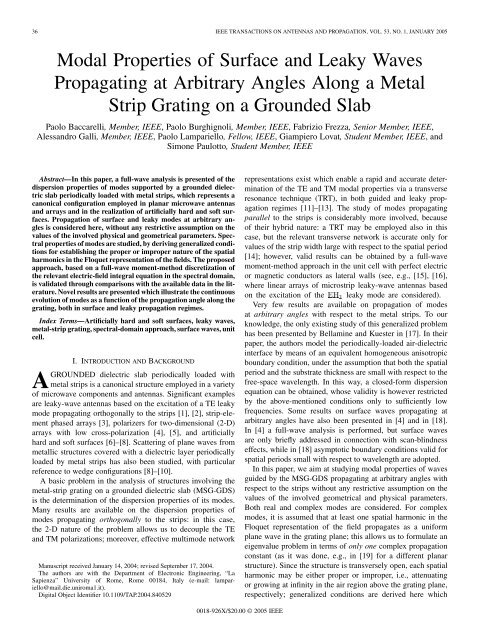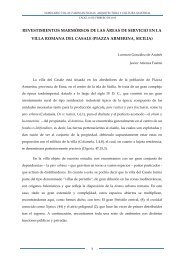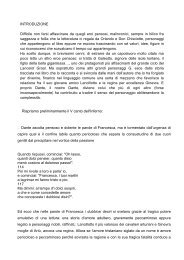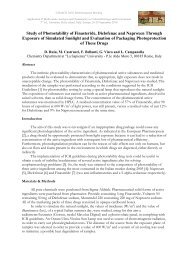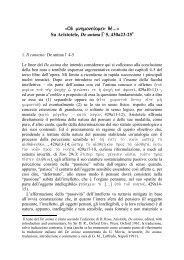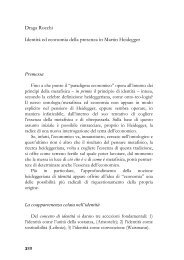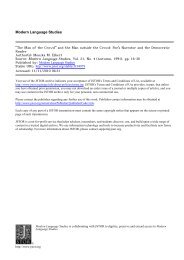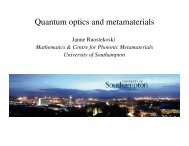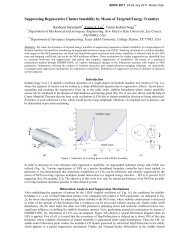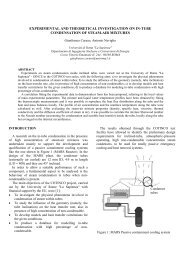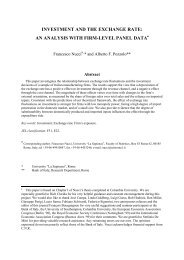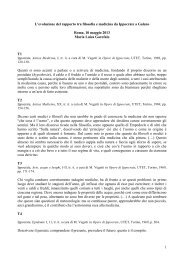Modal Properties of Surface and Leaky Waves ... - La Sapienza
Modal Properties of Surface and Leaky Waves ... - La Sapienza
Modal Properties of Surface and Leaky Waves ... - La Sapienza
You also want an ePaper? Increase the reach of your titles
YUMPU automatically turns print PDFs into web optimized ePapers that Google loves.
36 IEEE TRANSACTIONS ON ANTENNAS AND PROPAGATION, VOL. 53, NO. 1, JANUARY 2005<br />
<strong>Modal</strong> <strong>Properties</strong> <strong>of</strong> <strong>Surface</strong> <strong>and</strong> <strong>Leaky</strong> <strong>Waves</strong><br />
Propagating at Arbitrary Angles Along a Metal<br />
Strip Grating on a Grounded Slab<br />
Paolo Baccarelli, Member, IEEE, Paolo Burghignoli, Member, IEEE, Fabrizio Frezza, Senior Member, IEEE,<br />
Aless<strong>and</strong>ro Galli, Member, IEEE, Paolo <strong>La</strong>mpariello, Fellow, IEEE, Giampiero Lovat, Student Member, IEEE, <strong>and</strong><br />
Simone Paulotto, Student Member, IEEE<br />
Abstract—In this paper, a full-wave analysis is presented <strong>of</strong> the<br />
dispersion properties <strong>of</strong> modes supported by a grounded dielectric<br />
slab periodically loaded with metal strips, which represents a<br />
canonical configuration employed in planar microwave antennas<br />
<strong>and</strong> arrays <strong>and</strong> in the realization <strong>of</strong> artificially hard <strong>and</strong> s<strong>of</strong>t surfaces.<br />
Propagation <strong>of</strong> surface <strong>and</strong> leaky modes at arbitrary angles<br />
is considered here, without any restrictive assumption on the<br />
values <strong>of</strong> the involved physical <strong>and</strong> geometrical parameters. Spectral<br />
properties <strong>of</strong> modes are studied, by deriving generalized conditions<br />
for establishing the proper or improper nature <strong>of</strong> the spatial<br />
harmonics in the Floquet representation <strong>of</strong> the fields. The proposed<br />
approach, based on a full-wave moment-method discretization <strong>of</strong><br />
the relevant electric-field integral equation in the spectral domain,<br />
is validated through comparisons with the available data in the literature.<br />
Novel results are presented which illustrate the continuous<br />
evolution <strong>of</strong> modes as a function <strong>of</strong> the propagation angle along the<br />
grating, both in surface <strong>and</strong> leaky propagation regimes.<br />
Index Terms—Artificially hard <strong>and</strong> s<strong>of</strong>t surfaces, leaky waves,<br />
metal-strip grating, spectral-domain approach, surface waves, unit<br />
cell.<br />
I. INTRODUCTION AND BACKGROUND<br />
AGROUNDED dielectric slab periodically loaded with<br />
metal strips is a canonical structure employed in a variety<br />
<strong>of</strong> microwave components <strong>and</strong> antennas. Significant examples<br />
are leaky-wave antennas based on the excitation <strong>of</strong> a TE leaky<br />
mode propagating orthogonally to the strips [1], [2], strip-element<br />
phased arrays [3], polarizers for two-dimensional (2-D)<br />
arrays with low cross-polarization [4], [5], <strong>and</strong> artificially<br />
hard <strong>and</strong> s<strong>of</strong>t surfaces [6]–[8]. Scattering <strong>of</strong> plane waves from<br />
metallic structures covered with a dielectric layer periodically<br />
loaded by metal strips has also been studied, with particular<br />
reference to wedge configurations [8]–[10].<br />
A basic problem in the analysis <strong>of</strong> structures involving the<br />
metal-strip grating on a grounded dielectric slab (MSG-GDS)<br />
is the determination <strong>of</strong> the dispersion properties <strong>of</strong> its modes.<br />
Many results are available on the dispersion properties <strong>of</strong><br />
modes propagating orthogonally to the strips: in this case,<br />
the 2-D nature <strong>of</strong> the problem allows us to decouple the TE<br />
<strong>and</strong> TM polarizations; moreover, effective multimode network<br />
Manuscript received January 14, 2004; revised September 17, 2004.<br />
The authors are with the Department <strong>of</strong> Electronic Engineering, “<strong>La</strong><br />
<strong>Sapienza</strong>” University <strong>of</strong> Rome, Rome 00184, Italy (e-mail: lampariello@mail.die.uniroma1.it).<br />
Digital Object Identifier 10.1109/TAP.2004.840529<br />
0018-926X/$20.00 © 2005 IEEE<br />
representations exist which enable a rapid <strong>and</strong> accurate determination<br />
<strong>of</strong> the TE <strong>and</strong> TM modal properties via a transverse<br />
resonance technique (TRT), in both guided <strong>and</strong> leaky propagation<br />
regimes [11]–[13]. The study <strong>of</strong> modes propagating<br />
parallel to the strips is considerably more involved, because<br />
<strong>of</strong> their hybrid nature: a TRT may be employed also in this<br />
case, but the relevant transverse network is accurate only for<br />
values <strong>of</strong> the strip width large with respect to the spatial period<br />
[14]; however, valid results can be obtained by a full-wave<br />
moment-method approach in the unit cell with perfect electric<br />
or magnetic conductors as lateral walls (see, e.g., [15], [16],<br />
where linear arrays <strong>of</strong> microstrip leaky-wave antennas based<br />
on the excitation <strong>of</strong> the leaky mode are considered).<br />
Very few results are available on propagation <strong>of</strong> modes<br />
at arbitrary angles with respect to the metal strips. To our<br />
knowledge, the only existing study <strong>of</strong> this generalized problem<br />
has been presented by Bellamine <strong>and</strong> Kuester in [17]. In their<br />
paper, the authors model the periodically-loaded air-dielectric<br />
interface by means <strong>of</strong> an equivalent homogeneous anisotropic<br />
boundary condition, under the assumption that both the spatial<br />
period <strong>and</strong> the substrate thickness are small with respect to the<br />
free-space wavelength. In this way, a closed-form dispersion<br />
equation can be obtained, whose validity is however restricted<br />
by the above-mentioned conditions only to sufficiently low<br />
frequencies. Some results on surface waves propagating at<br />
arbitrary angles have also been presented in [4] <strong>and</strong> in [18].<br />
In [4] a full-wave analysis is performed, but surface waves<br />
are only briefly addressed in connection with scan-blindness<br />
effects, while in [18] asymptotic boundary conditions valid for<br />
spatial periods small with respect to wavelength are adopted.<br />
In this paper, we aim at studying modal properties <strong>of</strong> waves<br />
guided by the MSG-GDS propagating at arbitrary angles with<br />
respect to the strips without any restrictive assumption on the<br />
values <strong>of</strong> the involved geometrical <strong>and</strong> physical parameters.<br />
Both real <strong>and</strong> complex modes are considered. For complex<br />
modes, it is assumed that at least one spatial harmonic in the<br />
Floquet representation <strong>of</strong> the field propagates as a uniform<br />
plane wave in the grating plane; this allows us to formulate an<br />
eigenvalue problem in terms <strong>of</strong> only one complex propagation<br />
constant (as it was done, e.g., in [19] for a different planar<br />
structure). Since the structure is transversely open, each spatial<br />
harmonic may be either proper or improper, i.e., attenuating<br />
or growing at infinity in the air region above the grating plane,<br />
respectively; generalized conditions are derived here which
BACCARELLI et al.: MODAL PROPERTIES OF SURFACE AND LEAKY WAVES PROPAGATING 37<br />
allow us to determine when each spatial harmonic changes its<br />
proper or improper character as one <strong>of</strong> the involved physical<br />
parameters (e.g., frequency or propagation angle) is varied,<br />
thus changing the spectral character <strong>of</strong> the considered mode.<br />
Numerical results are provided, based on a full-wave moment-method<br />
discretization <strong>of</strong> the relevant electric-field integral<br />
equation (EFIE) in the unit cell in the presence <strong>of</strong> an arbitrary<br />
phase shift between adjacent cells. The adopted numerical<br />
approach, originally developed in [16] for the analysis <strong>of</strong> linear<br />
phased arrays <strong>of</strong> microstrip leaky-wave antennas, has been<br />
adapted here to solve the homogeneous eigenvalue problem<br />
<strong>of</strong> determining surface <strong>and</strong> leaky waves propagating along an<br />
arbitrary oblique direction in the grating plane. The accuracy<br />
<strong>of</strong> the proposed approach is validated by comparison with the<br />
dispersion data available in the literature. Novel interesting<br />
results are presented which illustrate the continuous evolution<br />
<strong>of</strong> modes from propagation orthogonal to propagation parallel<br />
to the strips, as a function <strong>of</strong> the angle, in different frequency<br />
ranges <strong>and</strong> propagation regimes.<br />
The paper is organized as follows. In Section II the Floquet<br />
representation <strong>of</strong> the sought modal fields is described <strong>and</strong><br />
the main features <strong>of</strong> the adopted moment-method approach<br />
are summarized. In Section III spectral properties <strong>of</strong> modes<br />
are studied. In Section IV numerical results are presented for<br />
different structures. Finally, in Section V conclusions are drawn<br />
on the various results <strong>of</strong> this study.<br />
II. ANALYSIS<br />
The MSG-GDS considered here is shown in Fig. 1(a) with the<br />
relevant coordinate system; it consists <strong>of</strong> an infinite array <strong>of</strong> perfectly-conducting<br />
metal strips <strong>of</strong> width <strong>and</strong> negligible thickness,<br />
periodically arranged along the direction with spatial<br />
period ,infinitely long in the direction, placed on a grounded<br />
lossless dielectric slab <strong>of</strong> relative permittivity , relative permeability<br />
, <strong>and</strong> thickness . <strong>Modal</strong> fields <strong>of</strong> the MSG-GDS<br />
will be considered in the following, with a time dependence<br />
assumed <strong>and</strong> suppressed throughout.<br />
A. Homogeneous Modes Propagating at an Arbitrary Angle<br />
The MSG-GDS is uniform along the direction <strong>and</strong> periodic<br />
along the direction. Therefore, the sought modal fields<br />
have an exponential dependence on , with propagation constant<br />
, <strong>and</strong> they admit a Floquet representation along<br />
involving an infinite number <strong>of</strong> spatial harmonics with propagation<br />
constants ;<br />
the electric field may be expressed as [20]<br />
(<strong>and</strong> similarly for the magnetic field ), where<br />
is the wave vector in the plane <strong>of</strong> the th spatial harmonic<br />
<strong>and</strong> is the position vector in the same<br />
plane.<br />
(1)<br />
Fig. 1. Reference MSG-GDS: (a) Edge view, with geometrical <strong>and</strong> physical<br />
parameters <strong>and</strong> (b) 3-D view, with the phase vector <strong>and</strong> attenuation vector<br />
<strong>of</strong> the aHspatial harmonic <strong>of</strong> a mode propagating along the plane in<br />
the direction <strong>of</strong> the unit vector at an angle 0 with respect to the positive <br />
axis.<br />
By letting , it can be observed that each spatial<br />
harmonic propagates in the plane with a different phase<br />
vector but with the same attenuation vector . We aim here<br />
at studying homogeneous modes <strong>of</strong> the MSG-GDS, defined as<br />
modes with at least one spatial harmonic (the , without<br />
loss <strong>of</strong> generality) propagating as an homogeneous plane wave<br />
at an angle in the plane [19]. This corresponds to assume that<br />
where is a complex scalar propagation constant <strong>and</strong><br />
is the real unit vector whose direction makes an angle with<br />
respect to the positive axis [see Fig. 1(b)]. Therefore, from (2)<br />
<strong>and</strong> (3) we obtain<br />
The assumption <strong>of</strong> a homogeneous mode is certainly satisfied<br />
for propagation at (i.e., across the strips) <strong>and</strong><br />
(i.e., along the strips), <strong>and</strong> also when , i.e., for<br />
real modes; moreover, it allows us to formulate an eigenvalue<br />
problem in terms <strong>of</strong> only one complex unknown (i.e., the propagation<br />
constant ), as described in the next subsection.<br />
(2)<br />
(3)<br />
(4)
38 IEEE TRANSACTIONS ON ANTENNAS AND PROPAGATION, VOL. 53, NO. 1, JANUARY 2005<br />
Fig. 2. Phase vectors <strong>of</strong> the spatial harmonics aH, 61 <strong>of</strong> a physical proper real mode in the plane <strong>of</strong> the phase constants ( , ). The circles (shaded areas)<br />
are the visible spaces for the spatial harmonics.<br />
B. Spectral-Domain Approach in the Unit Cell<br />
The periodicity <strong>of</strong> the structure along allows us to restrict<br />
the analysis to only one spatial period (unit cell), e.g., the one<br />
limited by the planes <strong>and</strong> [20]. The modal<br />
current on the strip in the unit cell can be written as<br />
The unknown can be represented as a linear combination<br />
<strong>of</strong> a finite number <strong>of</strong> basis functions , ,<br />
whose coefficients may be found through a Galerkin momentmethod<br />
discretization <strong>of</strong> the relevant electric-field integral equation<br />
(EFIE) [16]. This leads to a linear algebraic system whose<br />
coefficient-matrix elements are given by infinite series<br />
In (6) the tilde indicates a Fourier transform with respect to<br />
<strong>and</strong> is the spectral dyadic Green’s function <strong>of</strong> the<br />
background GDS, which is known in a simple closed form [21].<br />
Once a propagation direction has been fixed, the matrix elements<br />
are seen to depend on the propagation constant<br />
through , , according to<br />
(4). The eigenvalues are then obtained as zeroes <strong>of</strong> the determinant<br />
<strong>of</strong> the coefficient matrix <strong>and</strong> the modal currents<br />
are the corresponding eigenvectors.<br />
We have adopted here st<strong>and</strong>ard weighted Chebishev polynomials<br />
as basis functions for the longitudinal <strong>and</strong> transverse components<br />
<strong>of</strong> the unknown current [20]; for details on the implementation,<br />
including numerical acceleration <strong>of</strong> the series in<br />
(6), we refer to [16].<br />
III. SPECTRAL PROPERTIES OF HOMOGENEOUS MODES<br />
A basic point <strong>of</strong> the modal analysis is related to the behavior<br />
<strong>of</strong> the electromagnetic field <strong>of</strong> each spatial harmonic in the air<br />
region above the grating plane. In such a region, the<br />
field <strong>of</strong> the th spatial harmonic depends on the transverse<br />
coordinate as<br />
given by<br />
, where the propagation constant is<br />
(5)<br />
(6)<br />
(7)<br />
The presence <strong>of</strong> a square root in (7) makes the transverse<br />
propagation constant a two-valued function <strong>of</strong> the modal<br />
propagation constant . The determination <strong>of</strong> with<br />
corresponds to fields exponentially<br />
decaying at infinity in the direction (proper determination),<br />
while the determination with corresponds<br />
to fields exponentially growing at infinity (improper<br />
determination). The proper or improper nature <strong>of</strong> each spatial<br />
harmonic in the infinite series in (6) determines the spectral<br />
character <strong>of</strong> the modal solution [22].<br />
The simplest case is that <strong>of</strong> a mode with a real propagation<br />
constant . From (7) we then find that is either<br />
purely real or purely imaginary. The mode is physical only if<br />
it is attenuated in the air region at infinity along , i.e., is<br />
purely imaginary with for all . This is possible if the<br />
argument <strong>of</strong> the square-root function in (7) is negative for all ,<br />
i.e., is outside the visible space <strong>of</strong> the th spatial harmonic,<br />
defined by the circle in the , plane<br />
for all (see Fig. 2), <strong>and</strong> the proper determination is chosen for<br />
all the spatial harmonics.<br />
As is well known from the theory <strong>of</strong> open periodic structures,<br />
by varying a physical parameter (e.g., the frequency or, in<br />
the present case, the propagation angle ), a proper real mode<br />
may evolve into a complex mode (e.g., in stopb<strong>and</strong> or in radiative<br />
ranges), <strong>and</strong> one or more spatial harmonics may become<br />
improper [22]. In the latter case, the mode changes its spectral<br />
character, <strong>and</strong> this may happen only if the solution crosses the<br />
branch point or branch cut associated to one (or more) <strong>of</strong> the<br />
infinite square-root functions in (7) in the plane.<br />
In the following analysis, conditions for branch-point <strong>and</strong><br />
branch-cut crossing will be derived. They will be expressed in<br />
geometrical terms with reference to the evolution <strong>of</strong> the phase<br />
vector , by varying one physical parameter, in the plane <strong>of</strong><br />
the phase constants ( , ).<br />
A. Conditions for Branch-Point <strong>and</strong> Branch-Cut Crossings<br />
The branch cut (BC) in the complex plane which separates<br />
the proper <strong>and</strong> improper Riemann sheets for the squareroot<br />
function in (7) is defined by the conditions ,<br />
(8)
BACCARELLI et al.: MODAL PROPERTIES OF SURFACE AND LEAKY WAVES PROPAGATING 39<br />
as<br />
. By letting , these can be written<br />
(9a)<br />
(9b)<br />
Branch-point (BP) crossing occurs when the equal sign holds in<br />
(9b).<br />
In order to satisfy (9a), we see that two cases are possible,<br />
namely<br />
or<br />
Let us consider them separately.<br />
1) Case 1: When (10) holds, from (7) we have<br />
(10)<br />
(11)<br />
(12)<br />
Therefore, by considering the definition <strong>of</strong> visible space given<br />
in (8), it can easily be seen that (9b) is satisfied when the curve<br />
described by the phase vector in the ( , ) plane lies in<br />
the visible space <strong>of</strong> the th spatial harmonic <strong>and</strong> the mode has<br />
a zero attenuation constant. In particular, BP crossing occurs<br />
at the edge <strong>of</strong> such a visible space. In the special case<br />
(propagation across the strips) the well-known condition for BP<br />
crossing is recovered [22].<br />
2) Case 2: When (11) holds, by substituting it in (9b) a<br />
second-order inequality in is obtained<br />
(13)<br />
The right-h<strong>and</strong> side <strong>of</strong> (13) is negative inside (<strong>and</strong> positive outside)<br />
the angular sector delimited by the half-lines tangent to the<br />
th visible-space edge through the origin <strong>of</strong> the ( , ) plane<br />
(see Fig. 3), so that (13) is certainly satisfied inside this sector for<br />
any value <strong>of</strong> . On the other h<strong>and</strong>, (11) corresponds to a circle<br />
in the ( , ) plane centered at with radius<br />
(see Fig. 4). Therefore, in this case the BC is crossed when the<br />
curve described by the phase vector in the ( , ) plane<br />
crosses the circle <strong>of</strong> (11): i) inside the th visible space with<br />
any attenuation constant [see Fig. 4(a)], or ii) outside the th<br />
visible space for any value <strong>of</strong> the attenuation constant such that<br />
(14)<br />
[see Fig. 4(b)]. In the latter case, BP crossing occurs when the<br />
equal sign holds in (14).<br />
It can be observed that (11) is equivalent to the condition<br />
<strong>of</strong> orthogonality between the phase vectors <strong>and</strong> (see<br />
Fig. 4). In fact<br />
(15)<br />
Fig. 3. Illustration <strong>of</strong> Case 2 <strong>of</strong> BC or BP crossing, for the a 0I spatial<br />
harmonic: angular range (shaded area) where the right-h<strong>and</strong> side <strong>of</strong> (13) is<br />
negative.<br />
Fig. 4. Illustration <strong>of</strong> Case 2 <strong>of</strong> BC or BP crossing, for the a 0I spatial<br />
harmonic: orthogonality <strong>of</strong> the phase vectors <strong>and</strong> when lies on<br />
the circle <strong>of</strong> (11) (dashed line). (a) Case <strong>of</strong> inside the a 0I visible space;<br />
(b) case <strong>of</strong> outside the a 0I visible space.<br />
In the special case (propagation across the strips) the<br />
well-known condition for branch-cut crossing is recovered,<br />
which corresponds to the th spatial harmonic radiating at<br />
broadside [22].<br />
IV. NUMERICAL RESULTS<br />
In this section, numerical results on modal properties <strong>of</strong><br />
different structures will be presented. In Section IV-A, comparisons<br />
are shown with dispersion diagrams available in the<br />
literature, obtained with different techniques, in order to validate<br />
the accuracy <strong>of</strong> the proposed full-wave moment-method
40 IEEE TRANSACTIONS ON ANTENNAS AND PROPAGATION, VOL. 53, NO. 1, JANUARY 2005<br />
approach. In Section IV-B, results on two specific structures<br />
are presented in different frequency ranges, which show various<br />
peculiar features <strong>of</strong> modal propagation at arbitrary angles.<br />
Illustrative results on the novel spectral features discussed in<br />
Section III are given in Section IV-C.<br />
A. Comparisons With Independent Results<br />
In Fig. 5, the normalized phase constant<br />
a function <strong>of</strong> the normalized propagation angle<br />
is reported as<br />
for a real proper mode <strong>of</strong> a structure with , ,<br />
, <strong>and</strong> , corresponding to Fig. 2 <strong>of</strong> [17]<br />
(case , <strong>of</strong> that paper). The mode is classified<br />
as a ‘grating mode’ [4], [17], [18] since its phase constant<br />
tends to infinity as tends to 0 . The agreement with<br />
the reference results in Fig. 2 <strong>of</strong> [17] is excellent. In Fig. 6, the<br />
normalized phase constant <strong>and</strong> the normalized attenuation<br />
constant are reported as a function <strong>of</strong> the normalized<br />
propagation angle for a complex improper<br />
(leaky) mode (with the spatial harmonic improper) <strong>of</strong> a<br />
structure with , , , <strong>and</strong> ,<br />
corresponding to Fig. 4 <strong>of</strong> [17]. Again, the agreement is excellent<br />
in the whole angular range.<br />
As a further test on the accuracy <strong>of</strong> our full-wave approach,<br />
comparisons have been performed with results obtained through<br />
a TRT approach for propagation at . In Fig. 7, a Brillouin<br />
diagram ( vs. ) is shown for the spatial<br />
harmonic <strong>of</strong> the fundamental mode propagating on<br />
a MSG-GDS with , , ,<br />
, corresponding to Fig. 4 <strong>of</strong> [23]. The corresponding<br />
unperturbed modes <strong>of</strong> the parallel-plate waveguide (PPW)<br />
<strong>and</strong> grounded dielectric slab (GDS) are also reported. Again the<br />
comparison shows exact agreement both in the proper range,<br />
between <strong>and</strong> , <strong>and</strong> in the improper<br />
range (with the<br />
.<br />
spatial harmonic improper), below<br />
B. <strong>Modal</strong> Features <strong>of</strong> Propagation at Different Angles<br />
In order to illustrate the continuous mode evolution from<br />
propagation across the strips to propagation along the<br />
strips , we consider here a MSG-GDS with ,<br />
,<br />
chosen as in [24]).<br />
, <strong>and</strong> (parameters<br />
In the case , as mentioned in Section I, modes are either<br />
TE or TM <strong>and</strong> may be regarded as the TE <strong>and</strong> TM modes <strong>of</strong><br />
a GDS perturbed by the presence <strong>of</strong> the metal-strip grating or,<br />
alternatively, as the TE <strong>and</strong> TM modes <strong>of</strong> a PPW perturbed by<br />
the presence <strong>of</strong> slots in the upper plate. In Fig. 8(a), the Brillouin<br />
diagrams <strong>of</strong> the fundamental (perturbed) <strong>and</strong> modes<br />
are reported in the first Brillouin zone . The diagram<br />
is symmetric with respect to the vertical axis ;<br />
thick lines correspond to the direct spatial harmonic,<br />
which contributes to field representation for positive values <strong>of</strong><br />
the coordinate; thin lines correspond to the reverse<br />
spatial harmonic, which contributes to field representation for<br />
negative . The mode has cut<strong>of</strong>f at zero frequency, while<br />
the mode has cut<strong>of</strong>f at , i.e., between<br />
Fig. 5. Full-wave normalized phase constant a as a function <strong>of</strong> the<br />
normalized propagation angle @WH 0 0AaIVH for a real proper mode <strong>of</strong><br />
‘grating’ type <strong>of</strong> a structure with 4 aPXP, aHXP, a aHXWW, <strong>and</strong><br />
a aIXH, corresponding to Fig. 2 <strong>of</strong> [17] (case —a aHXHI, a aI<strong>of</strong><br />
that paper).<br />
Fig. 6. Full-wave normalized phase constant a (solid line) <strong>and</strong><br />
normalized attenuation constant a (dashed line) as a function <strong>of</strong> the<br />
normalized propagation angle @WH 0 0AaIVH for a complex improper (leaky)<br />
mode (with the aHspatial harmonic improper) <strong>of</strong> a structure with 4 aPXP,<br />
aHXU, a aHXW, <strong>and</strong> a aIXH, corresponding to Fig. 4 <strong>of</strong> [17].<br />
(GDS cut<strong>of</strong>f) <strong>and</strong><br />
(PPW cut<strong>of</strong>f). Real proper branches are represented with<br />
solid lines; complex proper branches are represented with short<br />
dashed lines: they occur in the stopb<strong>and</strong> regions (shaded areas),<br />
where the modes are bound <strong>and</strong> attenuated, <strong>and</strong> outside the<br />
bound-mode triangle, where the modes are radiative due to the<br />
spatial harmonic radiating in the backward quadrant<br />
[22].<br />
When the propagation angle is , the structure may<br />
be regarded as an infinite linear array <strong>of</strong> microstrip lines in the<br />
absence <strong>of</strong> a phase shift between elements. In this case modes<br />
are hybrid; the planes , , that divide each<br />
metal strip, are symmetry planes which may be either PMC or<br />
PEC; modes are classified accordingly as even or odd modes.<br />
It is to be noted that symmetry requires that also the planes<br />
, , located in the middle <strong>of</strong> adjacent<br />
strips, are PMC for even modes while they are PEC for odd<br />
modes, i.e., all the symmetry planes are <strong>of</strong> the same kind. The<br />
latter property directly affects the nature <strong>of</strong> leaky modes; in fact,<br />
the air region <strong>of</strong> the unit cell above the MSG-GDS, bounded<br />
by such PMC or PEC walls, can be regarded as a parallel-plate
BACCARELLI et al.: MODAL PROPERTIES OF SURFACE AND LEAKY WAVES PROPAGATING 41<br />
Fig. 7. Full-wave Brillouin diagram ( a% vs. a%) for the aHspatial<br />
harmonic <strong>of</strong> the fundamental TE mode propagating on a structure with 4 a<br />
PH, a HXIR , a HXQQV , a a HXT, corresponding to Fig. 4 <strong>of</strong><br />
[23]. Legend: proper solutions (solid line); improper solutions (dashed line). The<br />
edges <strong>of</strong> the first bound-mode triangle are represented by light dotted lines. The<br />
unperturbed „i modes <strong>of</strong> the parallel-plate waveguide (PPW) <strong>and</strong> grounded<br />
dielectric slab (GDS) are represented with gray dotted lines.<br />
waveguide, which supports a TEM wave with propagation constant<br />
equal to <strong>and</strong> with the magnetic or the electric field orthogonal<br />
to the PMC or PEC planes, respectively. A leaky mode<br />
may radiate into such a TEM wave propagating at an angle in<br />
the plane, so that modal cut<strong>of</strong>f for all the higher-order modes<br />
occurs when .<br />
In Fig. 8(b) the dispersion diagrams <strong>of</strong> the first two even<br />
modes <strong>and</strong> <strong>of</strong> the first odd mode are reported in a frequency<br />
range from 0 to 18 GHz. The mode labeled corresponds<br />
to the fundamental mode <strong>of</strong> the isolated microstrip, perturbed<br />
by the presence <strong>of</strong> the other array elements. It is always<br />
real proper <strong>and</strong> has cut<strong>of</strong>f at zero frequency. The mode labeled<br />
is the perturbed first higher-order mode <strong>of</strong> the isolated<br />
microstrip line [16]. It is proper real above its cut<strong>of</strong>f frequency<br />
<strong>and</strong> its phase constant is close to the phase<br />
constant <strong>of</strong> the unperturbed mode <strong>of</strong> the GDS above its<br />
cut<strong>of</strong>f frequency ; in fact, the TE modes <strong>of</strong> the<br />
GDS are perturbed very little by narrow strips placed along their<br />
direction <strong>of</strong> propagation, since their electric field is transverse<br />
to the strips. Below cut<strong>of</strong>f, the mode has a real improper<br />
continuation (with the spatial harmonic improper); such<br />
real improper solution originates, at lower frequencies, a complex<br />
improper solution. The mode labeled is an additional<br />
even mode with cut<strong>of</strong>f at zero frequency, where its phase constant<br />
is . It exists due to the presence <strong>of</strong> PMC lateral<br />
walls in the unit cell, thus it does not have a counterpart in the<br />
isolated microstrip line.<br />
In the next three figures, the evolution <strong>of</strong> the modes reported<br />
in Figs. 8(a) <strong>and</strong> (b) is shown as a function <strong>of</strong> the propagation<br />
angle in the range [0 ,90 ] at different frequencies. Results<br />
will be presented in the plane <strong>of</strong> the normalized phase constants<br />
( , ); by virtue <strong>of</strong> the symmetries <strong>of</strong> the structure,<br />
results for propagation angles outside the range [0 ,90 ] may<br />
be obtained by specular reflection <strong>of</strong> the reported curves with<br />
respect to the horizontal <strong>and</strong> vertical axes, which correspond to<br />
propagation at <strong>and</strong> at , respectively.<br />
Fig. 8. (a) Brillouin diagram ( a% vs. a%) for the fundamental TM <strong>and</strong><br />
TE modes propagating across the strips @0 aH A; direct modes (thick lines),<br />
reverse modes (thin lines); the shaded areas represent their stopb<strong>and</strong> regions.<br />
The edges <strong>of</strong> the first bound-mode triangle are represented by light dotted lines.<br />
On the right vertical axis also frequencies are reported in GHz. (b) Dispersion<br />
diagram ( a <strong>and</strong> a vs. frequency ) for the first two even <strong>and</strong> the<br />
first odd modes propagating along the strips @0 aWH A. Physical parameters:<br />
4 a PH, a HXIR , a HXQQV , a a HXP. Legend: normalized<br />
phase constant a or a%: proper real (solid line); improper real (dotted<br />
line); complex proper (short dashed line); complex improper (long dashed line).<br />
Normalized attenuation constant a : dashed line.<br />
The case is considered first. From Fig. 8(a)<br />
it may be seen that at this frequency the mode is real<br />
proper while the mode is below cut<strong>of</strong>f; on the other<br />
h<strong>and</strong>, from Fig. 8(b) it may be seen that at this frequency the<br />
modes <strong>and</strong> are above cut<strong>of</strong>f, while the mode<br />
is below cut<strong>of</strong>f in a real improper range. In Fig. 9 the<br />
evolution <strong>of</strong> these modes by varying the propagation angle<br />
from to may be observed in the range<br />
[0 ,90]. In particular, the mode becomes a ’grating<br />
mode,’ whose phase constant tends to infinity as tends<br />
to 0 , describing a slowly-varying periodic line almost parallel<br />
to the horizontal axis. On the other h<strong>and</strong>, the mode<br />
remains proper real with a bounded phase constant for<br />
all propagation angles, describing an approximately-elliptical<br />
curve outside the visible space, <strong>and</strong> finally becomes<br />
the fundamental mode at [see Fig. 8(a)]. This<br />
means that the surface wave related to this proper real mode<br />
may propagate at all angles on this structure. Finally, two real<br />
improper branches originate from the vertical axis
42 IEEE TRANSACTIONS ON ANTENNAS AND PROPAGATION, VOL. 53, NO. 1, JANUARY 2005<br />
Fig. 9. <strong>Modal</strong> evolution in the ( a , a ) plane by varying the<br />
propagation angle 0 in the range [0 ,90] for a structure as in Fig. 8 at<br />
a IH qr. Legend: proper real solutions (black solid line); improper<br />
real solutions (dotted line); complex improper solution (dashed line). The<br />
visible-space edge for the a H spatial harmonic is represented by a gray<br />
solid line.<br />
Fig. 10. Same as in Fig. 9, at a IQ qr.<br />
in Fig. 9: the lower one is the continuation <strong>of</strong> the mode<br />
[see Fig. 8(b)], while the upper one is superimposed to the<br />
mode at . By decreasing , the two real improper<br />
branches merge to form a complex improper solution, which<br />
ends at on a higher-order TM leaky mode [not shown<br />
in Fig. 8(a)]; such a leaky mode is physical, since the curve is<br />
located inside the visible space <strong>of</strong> the spatial harmonic,<br />
however its attenuation constant (not shown here) is very high<br />
so that it is expected to give a negligible contribution to the<br />
representation <strong>of</strong> fields excited by finite sources.<br />
We consider now a higher frequency ; from<br />
Fig. 8 it may be seen that again at the only real proper<br />
mode is the mode, while at the mode is now<br />
above cut<strong>of</strong>f. In Fig. 10 the relevant modal evolution is reported.<br />
The fundamental mode again becomes a grating mode;<br />
however, the mode now is proper real <strong>and</strong> it remains proper<br />
real with a bounded propagation constant for all , becoming at<br />
the mode. On the other h<strong>and</strong>, the mode remains<br />
proper real only down to about , then its curve<br />
Fig. 11. Same as in Fig. 9, at a IV qr.<br />
becomes tangent to the visible-space edge <strong>and</strong> the<br />
spatial harmonic becomes improper. The mode thus becomes<br />
real improper, <strong>and</strong> it merges with the other real improper solution<br />
(superimposed to the mode at ) giving rise<br />
to a complex improper solution, which ends on a higher-order<br />
complex TM mode at ; such a leaky mode is nonphysical,<br />
since the curve is located outside the visible space <strong>of</strong> the<br />
spatial harmonic. It is interesting to observe that, by comparing<br />
the behaviors <strong>of</strong> the <strong>and</strong> modes in Figs. 9 <strong>and</strong> 10, it<br />
seems that they have exchanged their roles in relation with the<br />
mode propagating at .<br />
By further increasing the frequency to , from<br />
Fig. 8(a) it may be seen that the mode is above cut<strong>of</strong>f <strong>and</strong><br />
proper real; moreover, the mode is now above its stopb<strong>and</strong>.<br />
These features significantly change the picture <strong>of</strong> modal evolution<br />
as a function <strong>of</strong> the propagation angle, as shown in Fig. 11.<br />
In this case, the evolution <strong>of</strong> both direct <strong>and</strong> reverse modes at<br />
is shown in the range ;in<br />
this range, the real proper solutions (solid lines) are symmetric<br />
with respect to the vertical axis . It may be<br />
seen that the direct mode at remains proper real<br />
at all , becoming at the mode. Instead, both<br />
the direct <strong>and</strong> the reverse modes remain proper real up<br />
to about , then they merge to form a complex proper<br />
solution (dashed line) upto . The latter solution represents<br />
a mode with a very high attenuation constant (not shown<br />
here), which can be considered to be in a stopb<strong>and</strong> angular region.<br />
For the sake <strong>of</strong> completeness, the reverse mode is also<br />
shown, which is proper real up to , then becomes complex<br />
proper, with an evolution similar to that already described<br />
for the mode. It is interesting to observe that, at this frequency,<br />
both the mode <strong>and</strong> the mode at<br />
become grating modes by varying the propagation angle.<br />
As a general comment on modal evolution as a function <strong>of</strong><br />
the propagation angle, it may be observed that at all the considered<br />
frequencies in Figs. 9–11, at least one real proper solution<br />
exists at all angles with a bounded phase constant , which<br />
corresponds to a bound mode propagating along the MSG-GDS<br />
in all the directions. Moreover, the fundamental mode at<br />
always evolves into a grating mode.
BACCARELLI et al.: MODAL PROPERTIES OF SURFACE AND LEAKY WAVES PROPAGATING 43<br />
Fig. 12. (a) <strong>Modal</strong> evolution in the ( a , a ) plane for an improper<br />
complex (leaky) mode with the aHspatial harmonic improper (dashed line)<br />
on a structure as in Fig. 7 at a PIXW qr. (b) Normalized phase constant<br />
a (long dashed line) <strong>and</strong> normalized attenuation constant a (dashed<br />
line) as a function <strong>of</strong> the propagation angle 0.<br />
As concerns leaky modes, in Figs. 9 <strong>and</strong> 10 complex improper<br />
(leaky) solutions have been shown, which exist inside an angular<br />
neighborhood <strong>of</strong> . The existence <strong>of</strong> physical leaky<br />
modes propagating at all angles (as the mode reported in Fig. 6)<br />
has been investigated; it has been found that these may exist <strong>and</strong><br />
that reasonably-low values <strong>of</strong> their attenuation constant may be<br />
obtained. As an example, in Fig. 12 the case <strong>of</strong> a leaky mode on<br />
a structure as in Fig. 7 is reported. This mode is the continuation<br />
<strong>of</strong> the perturbed improper leaky mode propagating at<br />
[23]; at it is the continuation <strong>of</strong> a higher order<br />
even leaky mode. In Fig. 12(a) the relevant curve in the ( ,<br />
) plane may be seen to entirely lie inside the visible<br />
space, so that the mode is physical at all propagation angles. In<br />
Fig. 12(b) the corresponding behavior <strong>of</strong> the normalized phase<br />
<strong>and</strong> attenuation constants is shown; the values <strong>of</strong> the attenuation<br />
constant are such that directive conical radiation is to be<br />
expected due to the excitation <strong>of</strong> this mode by finite sources.<br />
C. Spectral Evolution as a Function <strong>of</strong> the Propagation Angle<br />
In order to illustrate some <strong>of</strong> the novel spectral features<br />
discussed in Section III, the same structure as in Fig. 8 is<br />
considered again here at higher frequencies. In particular, in<br />
Fig. 13 a dispersion diagram is reported for a mode propagating<br />
Fig. 13. (a) Normalized phase constant a <strong>and</strong> normalized attenuation<br />
constant a as a function <strong>of</strong> frequency for a complex (leaky) mode<br />
propagating at 0 aIH on a structure as in Fig. 8. (b) The same, in a narrower<br />
frequency range, with the BC line <strong>of</strong> the a 0I spatial harmonic (gray<br />
dashed-dotted line). Legend: normalized phase constant: proper solution (solid<br />
line); improper solution (dotted line). Normalized attenuation constant: dashed<br />
line.<br />
at , which is the continuation <strong>of</strong> the mode<br />
propagating at [see Fig. 8(a)]. In Fig. 13(a), the<br />
normalized phase constant (proper: solid line; improper: dotted<br />
line) <strong>and</strong> the normalized attenuation constant (dashed line)<br />
are reported in a wide frequency range from 25 to 30 GHz.<br />
At the mode is proper real; at ,<br />
the mode becomes proper complex <strong>and</strong> radiative (leaky), due<br />
to the spatial harmonic being fast. The attenuation<br />
constant in this range first increases, then decreases to zero,<br />
<strong>and</strong> finally raises steeply (at about ). The<br />
fundamental point to be stressed here is illustrated in the<br />
enlarged plot reported in Fig. 13(b), where the change <strong>of</strong><br />
the spatial harmonic from proper to improper is<br />
shown. In this plot, the quantity is also reported<br />
(gray dashed-dotted line), which represents the BC line <strong>of</strong><br />
the spatial harmonic: according to (11), when the<br />
phase-constant curve crosses this line, the spatial<br />
harmonic becomes improper. It is important to note that this<br />
happens before the sign <strong>of</strong> has changed <strong>and</strong> also before<br />
the attenuation constant has become zero; according to the<br />
discussion in Section III-A, this happens when the phase vectors
44 IEEE TRANSACTIONS ON ANTENNAS AND PROPAGATION, VOL. 53, NO. 1, JANUARY 2005<br />
Fig. 14. (a) Phase vector <strong>of</strong> the aHspatial harmonic in the ( a , a )<br />
plane for a mode as in Fig. 13 at a PQXUQ qr. (b) Normalized phase<br />
constant a <strong>and</strong> normalized attenuation constant a as a function <strong>of</strong><br />
the propagation angle 0. Legend: visible-space edge <strong>of</strong> the a 0I spatial<br />
harmonic (thick gray line); BC line <strong>of</strong> the a 0I spatial harmonic (thin gray<br />
line); other curves: as in Fig. 13.<br />
<strong>and</strong> are orthogonal. Instead, when propagation at<br />
is considered, the change <strong>of</strong> the spectral character <strong>of</strong><br />
the th spatial harmonic occurs exactly when <strong>and</strong><br />
the attenuation constant is equal to zero [22].<br />
It is also interesting to consider the spectral evolution <strong>of</strong><br />
modes by varying the propagation angle. In Fig. 14 the same<br />
mode as in Fig. 13 is considered, at the fixed frequency<br />
. In Fig. 14(a) the modal curve in the ( ,<br />
) plane is reported, together with the visible-space<br />
edge (thick gray line) <strong>and</strong> the circle <strong>of</strong> (11) (thin<br />
gray line); as pointed out in Section III-A, by crossing this<br />
circle inside the visible space, the branch cut is crossed<br />
<strong>and</strong> the spatial harmonic changes its spectral character.<br />
In Fig. 14(b), the relevant normalized phase <strong>and</strong> attenuation<br />
constants are plotted as a function <strong>of</strong> the propagation angle<br />
.At the mode is improper complex; by increasing<br />
, the curve in Fig. 14(a) crosses the gray circle (at )<br />
<strong>and</strong> the mode becomes proper complex (see Fig. 13(b), where<br />
). By further increasing , the curve again crosses the<br />
circle (at ) <strong>and</strong> the mode becomes improper complex.<br />
Finally, the curve touches the visible-space edge [see<br />
Fig. 14(a)] with a zero attenuation constant (at ), the<br />
mode becomes proper real <strong>and</strong> exits the visible space in a<br />
bound regime.<br />
V. CONCLUSION<br />
In this paper, an investigation on the fundamental properties<br />
<strong>of</strong> modes which propagate at arbitrary angles along a<br />
MSG-GDS has been presented, without any restrictive assumption<br />
on the physical or geometrical parameters <strong>of</strong> the structure.<br />
Homogeneous modes, i.e., modes with at least one spatial harmonic<br />
propagating as a homogeneous plane wave in the grating<br />
plane have been considered, by determining their propagation<br />
constant <strong>and</strong> modal current configuration through a full-wave,<br />
spectral-domain moment-method approach in the unit cell. Particular<br />
attention has been devoted to the issue <strong>of</strong> the spectral<br />
character <strong>of</strong> the considered modes, which is related to the proper<br />
or improper nature <strong>of</strong> the spatial harmonics: novel conditions<br />
which allow to continuously track the relevant modal solutions<br />
on the different Riemann sheets have been presented, generalizing<br />
those already known for propagation across or along the<br />
metal strips.<br />
Numerical results have been provided for different structures<br />
<strong>and</strong> frequency ranges in order to assess the accuracy <strong>of</strong> the<br />
proposed approach, by comparison with the available results<br />
in the literature <strong>and</strong> with different full-wave techniques, <strong>and</strong> to<br />
illustrate the main features <strong>of</strong> surface <strong>and</strong> leaky modes as the<br />
propagation angle in the grating plane is varied. In particular,<br />
it has been found that both surface modes <strong>and</strong> leaky modes<br />
that propagate at all angles may exist, <strong>and</strong> the investigation <strong>of</strong><br />
high-frequency regions has elucidated novel spectral features<br />
<strong>of</strong> the considered modes.<br />
REFERENCES<br />
[1] M. Guglielmi <strong>and</strong> G. Boccalone, “A novel theory for dielectric-inset<br />
waveguide antennas,” IEEE Trans. Antennas Propag., vol. 39, no. 4, pp.<br />
497–504, Apr. 1991.<br />
[2] M. Guglielmi <strong>and</strong> D. R. Jackson, “Broadside radiation from periodic<br />
leaky-wave antennas,” IEEE Trans. Antennas Propag., vol. 41, no. 1,<br />
pp. 31–37, Jan. 1993.<br />
[3] C. P. Nehra, A. Hessel, J. Shmoys, <strong>and</strong> H. J. Stalzer Jr., “Probe-fed stripelement<br />
microstrip phased arrays: E- <strong>and</strong> H-plane scan resonances <strong>and</strong><br />
broadb<strong>and</strong>ing guidelines,” IEEE Trans. Antennas Propag., vol. 43, no.<br />
11, pp. 1270–1280, Nov. 1995.<br />
[4] N. K. Das <strong>and</strong> A. Mohanty, “Infinite array <strong>of</strong> printed dipoles integrated<br />
with a printed strip grating for suppression <strong>of</strong> cross-polar radiation. Part<br />
I: rigorous analysis,” IEEE Trans. Antennas Propag., vol. 45, no. 6, pp.<br />
960–972, Jun. 1997.<br />
[5] A. Mohanty <strong>and</strong> N. K. Das, “Infinite array <strong>of</strong> printed dipoles integrated<br />
with a printed strip grating for suppression <strong>of</strong> cross-polar radiation. Part<br />
II: an idealized unidirectional conducting screen (UCS) model,” IEEE<br />
Trans. Antennas Propag., vol. 45, no. 6, pp. 973–981, Jun. 1997.<br />
[6] P. S. Kildal, “Definition <strong>of</strong> artificially s<strong>of</strong>t anf hard surface for electromagnetic<br />
waves,” Electron. Lett., vol. 24, no. 2, pp. 168–170, Feb. 1988.<br />
[7] E. Lier <strong>and</strong> T. Schaug-Pettersen, “The strip-loaded hybrid-mode feed<br />
horn,” IEEE Trans. Antennas Propag., vol. AP-35, no. 9, pp. 1086–1089,<br />
Sep. 1987.<br />
[8] S. Chen, M. Ando, <strong>and</strong> N. Goto, “Analytical expressions for reflection<br />
coefficients <strong>of</strong> artificially s<strong>of</strong>t <strong>and</strong> hard surfaces: dielectric slab loaded<br />
with a periodic array <strong>of</strong> strips over a ground plane,” Proc. Inst. Elect.<br />
Eng.—Microw. Antennas Propag., vol. 142, pp. 145–150, Apr. 1995.<br />
[9] J. A. Aas, “Plane-wave reflection properties <strong>of</strong> two artificially hard surfaces,”<br />
IEEE Trans. Antennas Propag., vol. 39, no. 5, pp. 651–656, May<br />
1991.
BACCARELLI et al.: MODAL PROPERTIES OF SURFACE AND LEAKY WAVES PROPAGATING 45<br />
[10] G. Manara, P. Nepa, <strong>and</strong> G. Pelosi, “High-frequency electromagnetic<br />
scattering by edges in artificially hard <strong>and</strong> s<strong>of</strong>t surfaces illuminated at<br />
oblique incidence,” IEEE Trans. Antennas Propag., vol. 48, no. 5, pp.<br />
790–800, May 2000.<br />
[11] M. Guglielmi <strong>and</strong> A. A. Oliner, “Multimode network description <strong>of</strong><br />
a planar periodic metal-strip grating at a dielectric interface—part I:<br />
rigorous network formulations. Part II: Small-aperture <strong>and</strong> small-obstacle<br />
solutions,” IEEE Trans. Microw. Theory Tech., vol. 37, no. 3, pp.<br />
534–551, Mar. 1989.<br />
[12] M. Guglielmi <strong>and</strong> H. Hochstadt, “Multimode network description <strong>of</strong> a<br />
planar periodic metal-strip grating at a dielectric interface—Part III: Rigorous<br />
solution,” IEEE Trans. Microw. Theory Tech., vol. 37, no. 5, pp.<br />
902–909, May 1989.<br />
[13] D. N. Filipović, “New explicit expressions for the coupling matrix elements<br />
related to scattering from a planar periodic single-strip grating,”<br />
IEEE Trans. Microw. Theory Tech., vol. 43, no. 7, pp. 1540–1544, Jul.<br />
1995.<br />
[14] A. A. Oliner, Scannable Millimeter Wave Arrays, Polytechnic University,<br />
New York, 1998.<br />
[15] C. Hu <strong>and</strong> C. C. Tzuang, “Analysis <strong>and</strong> design <strong>of</strong> large leaky-mode array<br />
employing the coupled-mode approach,” IEEE Trans. Microw. Theory<br />
Tech., vol. 49, no. 4, pp. 629–636, Apr. 2001.<br />
[16] P. Baccarelli, P. Burghignoli, C. Di Nallo, F. Frezza, A. Galli, P. <strong>La</strong>mpariello,<br />
<strong>and</strong> G. Ruggieri, “Full-wave analysis <strong>of</strong> printed leaky-wave phased<br />
arrays,” Int. J. RF <strong>and</strong> Microwave Computer Aided Eng., vol. 12, pp.<br />
272–287, May–Jun. 2002.<br />
[17] F. Bellamine <strong>and</strong> E. K. Kuester, “Guided waves along a metal grating on<br />
the surface <strong>of</strong> a grounded dielectric slab,” IEEE Trans. Microw. Theory<br />
Tech., vol. 42, no. 7, pp. 1190–1197, Jul. 1994.<br />
[18] Z. Sipus, H. Merkel, <strong>and</strong> P.-S. Kildal, “Green’s functions for planar s<strong>of</strong>t<br />
<strong>and</strong> hard surfaces derived by asymptotic boundary conditions,” Proc.<br />
Inst. Elect. Eng. Microw. Antennas Propag., vol. 144, pp. 321–328, Oct.<br />
1997.<br />
[19] H.-Y. D. Yang, R. Kim, <strong>and</strong> D. R. Jackson, “Design consideration for<br />
modeless integrated circuit substrates using planar periodic patches,”<br />
IEEE Trans. Microw. Theory Tech., vol. 48, no. 12, pp. 2233–2239, Dec.<br />
2000.<br />
[20] R. E. Collin, Field Theory <strong>of</strong> Guided <strong>Waves</strong>, 2nd ed. Piscataway, NJ:<br />
IEEE Press, 1991.<br />
[21] K. A. Michalski <strong>and</strong> J. R. Mosig, “Multilayered media Green’s functions<br />
in integral equation formulations,” IEEE Trans. Antennas Propag., vol.<br />
45, no. 3, pp. 508–519, Mar. 1997.<br />
[22] R. E. Collin <strong>and</strong> F. J. Zucker, Eds., Antenna Theory. New York: Mc-<br />
Graw-Hill, 1969, ch. 19.<br />
[23] P. Burghignoli, P. Baccarelli, F. Frezza, A. Galli, P. <strong>La</strong>mpariello, <strong>and</strong><br />
A. A. Oliner, “Low-frequency dispersion features <strong>of</strong> a new complex<br />
mode for a periodic strip grating on a grounded dielectric slab,”<br />
IEEE Trans. Microw. Theory Tech., vol. 49, no. 12, pp. 2197–2205,<br />
Dec. 2001.<br />
[24] S. Majumder, D. R. Jackson, A. A. Oliner, <strong>and</strong> M. Guglielmi, “The nature<br />
<strong>of</strong> the spectral gap for leaky waves on a periodic strip-grating structure,”<br />
IEEE Trans. Microw. Theory Tech., vol. 45, no. 12, pp. 2296–2307,<br />
Dec. 1997.<br />
Paolo Baccarelli (S’96–M’01) received the <strong>La</strong>urea<br />
degree in electronic engineering <strong>and</strong> the Ph.D. degree<br />
in applied electromagnetics from “<strong>La</strong> <strong>Sapienza</strong>”<br />
University <strong>of</strong> Rome, Rome, Italy, in 1996 <strong>and</strong> 2000,<br />
respectively.<br />
In 1996, he joined the Department <strong>of</strong> Electronic<br />
Engineering, “<strong>La</strong> <strong>Sapienza</strong>” University <strong>of</strong> Rome,<br />
where he has been a Contract Researcher since 2000.<br />
From April 1999 to October 1999, he was at the<br />
University <strong>of</strong> Houston, Houston, TX, as a Visiting<br />
Scholar. His research interests concern analysis <strong>and</strong><br />
design <strong>of</strong> planar leaky-wave antennas, numerical methods, periodic structures,<br />
<strong>and</strong> propagation <strong>and</strong> radiation in metamaterials <strong>and</strong> anisotropic media.<br />
Paolo Burghignoli (S’97–M’01) was born in Rome,<br />
Italy, on February 18, 1973. He received the <strong>La</strong>urea<br />
degree (cum laude) in electronic engineering <strong>and</strong> the<br />
Ph.D. degree in applied electromagnetics from “<strong>La</strong><br />
<strong>Sapienza</strong>” University <strong>of</strong> Rome, in 1997 <strong>and</strong> 2001, respectively.<br />
In 1997, he joined the Electronic Engineering<br />
Department <strong>of</strong> “<strong>La</strong> <strong>Sapienza</strong>” University <strong>of</strong> Rome,<br />
where he is currently a Contract Researcher. From<br />
January 2004 to July 2004, he was a Visiting<br />
Research Assistant Pr<strong>of</strong>essor at the University <strong>of</strong><br />
Houston, Houston, Texas. His scientific interests include analysis <strong>and</strong> design<br />
<strong>of</strong> planar leaky-wave antennas, numerical methods for the analysis <strong>of</strong> passive<br />
guiding <strong>and</strong> radiating microwave structures, periodic structures, <strong>and</strong> propagation<br />
<strong>and</strong> radiation in metamaterials.<br />
Dr. Burghignoli received the Graduate Fellowship Award from IEEE Microwave<br />
Theory <strong>and</strong> Techniques Society, in 2003.<br />
Fabrizio Frezza (S’87–M’90–SM’95) was born in<br />
Rome, Italy, on October 31, 1960. He received the<br />
<strong>La</strong>urea degree (cum laude) in electronic engineering<br />
<strong>and</strong> the Doctorate degree in applied electromagnetics<br />
from “<strong>La</strong> <strong>Sapienza</strong>” University <strong>of</strong> Rome, Rome, Italy,<br />
in 1986 <strong>and</strong> 1991, respecitvely.<br />
In 1986, he joined the Electronic Engineering<br />
Department <strong>of</strong> “<strong>La</strong> <strong>Sapienza</strong>” University <strong>of</strong> Rome,<br />
where he was a Researcher from 1990 to 1998, a<br />
temporary Pr<strong>of</strong>essor <strong>of</strong> Electromagnetics from 1994<br />
to 1998, <strong>and</strong> an Associate Pr<strong>of</strong>essor <strong>of</strong> Electromagnetics<br />
since 1998. His main research activity concerns guiding structures,<br />
antennas <strong>and</strong> resonators for microwaves <strong>and</strong> millimeter waves, numerical<br />
methods, scattering, optical propagation, plasma heating, <strong>and</strong> anisotropic<br />
media.<br />
Dr. Frezza is a Member <strong>of</strong> Sigma Xi, the European Microwave Association<br />
(EuMA), the Electrical <strong>and</strong> Electronic Italian Association (AEIT), <strong>and</strong> the<br />
Italian Society <strong>of</strong> Aeronautics <strong>and</strong> Astronautics (AIDAA).<br />
Aless<strong>and</strong>ro Galli (S’91–M’96) received the <strong>La</strong>urea<br />
degree in electronic engineering <strong>and</strong> the Ph.D. degree<br />
in applied electromagnetics from “<strong>La</strong> <strong>Sapienza</strong>” University<br />
<strong>of</strong> Rome, Rome, Italy, in 1990 <strong>and</strong> 1994, respectively.<br />
In 1990, he joined the Electronic Engineering<br />
Department <strong>of</strong> “<strong>La</strong> <strong>Sapienza</strong>” University <strong>of</strong> Rome,<br />
where he became an Assistant Pr<strong>of</strong>essor in 2000 <strong>and</strong><br />
an Associate Pr<strong>of</strong>essor <strong>of</strong> “Electromagnetic Fields”<br />
for Telecommunications Engineering in 2002. His<br />
scientific interests mainly involve electromagnetic<br />
theory <strong>and</strong> applications, particularly regarding analysis <strong>and</strong> design <strong>of</strong> passive<br />
devices <strong>and</strong> antennas (dielectric <strong>and</strong> anisotropic waveguides <strong>and</strong> resonators,<br />
leaky-wave antennas, etc.) for microwaves <strong>and</strong> millimeter waves. He is also<br />
active in bioelectromagnetics (modeling <strong>of</strong> interaction mechanisms with living<br />
matter, health safety problems for low-frequency applications <strong>and</strong> mobile<br />
communications, etc.).<br />
Dr. Galli received the Quality Presentation Recognition Award by the IEEE<br />
Microwave Theory <strong>and</strong> Techniques Society in 1994 <strong>and</strong> 1995.
46 IEEE TRANSACTIONS ON ANTENNAS AND PROPAGATION, VOL. 53, NO. 1, JANUARY 2005<br />
Paolo <strong>La</strong>mpariello (M’73–SM’82–F’96) was born<br />
in Rome, Italy, on May 17, 1944. He received the<br />
“<strong>La</strong>urea” degree (cum laude) in electronic engineering<br />
from the University <strong>of</strong> Rome, in 1971.<br />
In 1971, he joined the Institute <strong>of</strong> Electronics,<br />
University <strong>of</strong> Rome, where he was an Assistant<br />
Pr<strong>of</strong>essor <strong>of</strong> Electromagnetic Fields. Since 1976, he<br />
has been engaged in educational activities involving<br />
electromagnetic field theory <strong>and</strong> in 1986 he was<br />
made Pr<strong>of</strong>essor <strong>of</strong> Electromagnetic Fields. From<br />
November 1988 to October 1994, he served as Head<br />
<strong>of</strong> the Department <strong>of</strong> Electronic Engineering <strong>of</strong> “<strong>La</strong> <strong>Sapienza</strong>” University <strong>of</strong><br />
Rome, where, since November 1993, he has been the President <strong>of</strong> the Council<br />
for Electronic Engineering Curriculum, <strong>and</strong> since September 1995, he has<br />
been President <strong>of</strong> the Center Interdepartmental for Scientific Computing.<br />
From September 1980 to August 1981, he was a NATO Postdoctoral Research<br />
Fellow at the Polytechnic Institute <strong>of</strong> New York, Brooklyn. He has been<br />
engaged in research in a wide variety <strong>of</strong> topics in the microwave field, including<br />
electromagnetic <strong>and</strong> elastic wave propagation in anisotropic media, thermal<br />
effects <strong>of</strong> electromagnetic waves, network representations <strong>of</strong> microwave<br />
structures, guided-wave theory with stress on surface waves <strong>and</strong> leaky waves,<br />
traveling-wave antennas, phased arrays, <strong>and</strong>, more recently, guiding <strong>and</strong><br />
radiating structures for the millimeter <strong>and</strong> near-millimeter wave ranges.<br />
Pr<strong>of</strong>. <strong>La</strong>mpariello is Member <strong>of</strong> the Associazione Elettrotecnica de Elettronica<br />
Italiana (AEI). He is a past Chairman <strong>of</strong> the Central <strong>and</strong> South Italy<br />
Section <strong>of</strong> the IEEE <strong>and</strong> a past Chairman <strong>of</strong> the Microwave Theory <strong>and</strong><br />
Techniques/Antennas Propagation Societies Joint Chapter <strong>of</strong> the same Section.<br />
Presently he is the President <strong>of</strong> the Specialist Group “Electromagnetism” <strong>of</strong><br />
the AEI.<br />
Giampiero Lovat (S’02) was born in Rome, Italy, on<br />
May 31, 1975. He received the <strong>La</strong>urea degree (cum<br />
laude) in electronic engineering from “<strong>La</strong> <strong>Sapienza</strong>”<br />
University <strong>of</strong> Rome, in 2001, where he is working<br />
toward the Ph.D. degree in applied electromagnetics<br />
in the Electronic Engineering Department.<br />
From January 2004 to July 2004, he was a Visiting<br />
Scholar at the University <strong>of</strong> Houston, Houston, TX.<br />
His scientific interests include theoretical <strong>and</strong> numerical<br />
studies on leakage phenomena in planar structures<br />
<strong>and</strong> guidance <strong>and</strong> radiation in metamaterials <strong>and</strong><br />
general periodic structures.<br />
Simone Paulotto (S’97) received the <strong>La</strong>urea degree<br />
(cum laude <strong>and</strong> honorable mention) in electronic engineering<br />
from “<strong>La</strong> <strong>Sapienza</strong>” University <strong>of</strong> Rome,<br />
Rome, Italy, in 2002, where he is currently working<br />
toward the Ph.D. degree in applied electromagnetics.<br />
In 2002, he joined the Electronic Engineering<br />
Department <strong>of</strong> “<strong>La</strong> <strong>Sapienza</strong>” University <strong>of</strong> Rome.<br />
His scientific interests focus on electromagnetic<br />
propagation/radiation in planar structures <strong>and</strong> scattering<br />
theory.


